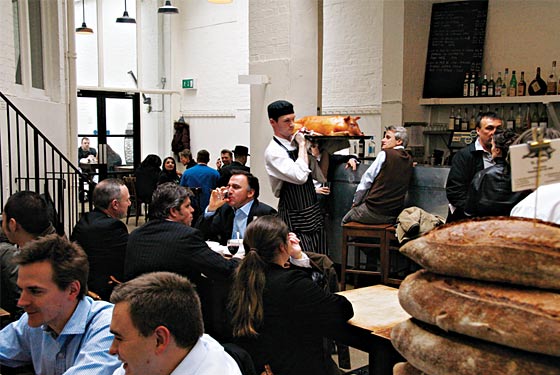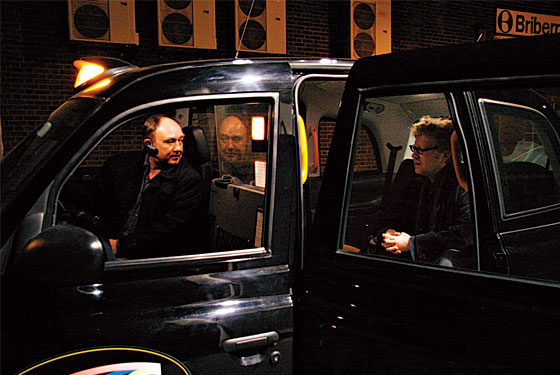
For generations of New Yorkers, “only in New York” is a proud and complex motto, at once wised-up verbal shrug and brash rallying cry. Above all, it’s the mantra of New York exceptionalism, the rosary we all say to remind ourselves of our belief that ours is the One True City. It’s a good line—as sharp and convincing as a hard jab. But after four years of living in London, we’re no longer so sure it’s true.
If Paris was the capital of the nineteenth century and New York of the twentieth, London is shaping up to be the capital of the 21st. It is not Britain and the United States that have a special relationship, it is London and New York—and it is that of wayward siblings, blood brothers who can’t stop wrestling for the top prize. They seem engaged in a constant battle for financial, cultural, and social supremacy, and the conjunction of their experiences (their oddly complementary mayors, the way the ritual dates 9/11 and 7/7 are inscribed in the memories of their residents, the speed with which the working class of each city is being priced out) only intensifies the competition. Increasingly, it seems as though London has the upper hand.
The signs are everywhere. Construction is booming, and a new wave of skyscrapers is being planned and built: Low-rise London is about to get high. Norman Foster’s eye-catching 30 St. Mary Axe building in the City of London, built in 2004 and widely known as the Gherkin, has garnered the most attention. But it’s only the first pickle out of the jar. Renzo Piano is planning a 1,000-foot building known as the Shard at Tower Bridge, SOM’s 540-foot Broadgate Tower near Liverpool Street Station is swiftly taking shape, and work is primed to start on a KPF-designed 940-foot tower just south of it. According to Mayor Ken Livingstone, London may have as many as twenty skyscrapers by 2015. This is transformative architecture, on the scale of Berlin or Shanghai in the nineties. How long has New York been waiting for a revamped Penn Station? Not to mention the dismal end result at ground zero.
To Londoners now, there’s a sense that the future belongs to them: It can sometimes seem as if there’s nobody over 30 on the streets, and that a great experiment in mass immigration and assimilation is under way. For a century, New Yorkers have taken it for granted that the most tired, the most poor, and the most huddled would bring their sharp-elbowed talents, their richness of spirit, to these shores. Increasingly, London may be their destination. Bengali, Portuguese, Turkish, Polish, and Vietnamese are the languages of the streets and buses. According to the 2001 census, some 2.2 million Londoners—30 percent of the city’s population—were born outside England. Some estimates suggest the figure is as much as 40 percent now; Poles, Lithuanians, Latvians, and others from Eastern Europe have been arriving at the rate of 16,000 a month since Eastern European nations were admitted to the EU in May 2004. At this rate, London will soon reach the level of foreign-born residents in New York during its great age of immigration, in the 1900s and 1910s. The extraordinary city that grew in those decades and the ones that followed owed much to their energy and enterprise, and the same is already true of London.

The boom in London may be most evident on the culture front. The Frieze Art Fair has in just four years helped transform a once staid art scene into a vital stop on the art-world circuit, and there has been an outpouring of English films, such as Michael Winterbottom’s Wonderland and Stephen Frears’s Dirty Pretty Things, that take the city and its changing population as their subject. It’s only a matter of time before someone makes a film as atmospheric and lyrical about London as Paul Strand and Charles Sheeler’s Manhatta. Oh, wait—members of the band St. Etienne already did: Finisterre, a paean to London’s jagged rhythms and moody charm. Even the city’s robust theater scene is experiencing an especially rich moment, with new plays by Tom Stoppard, David Hare, Michael Frayn, and Peter Morgan (the writer behind The Queen) being produced; Harold Pinter performing in Beckett’s Krapp’s Last Tape; and Kevin Spacey leading the resurgence of the Old Vic. As Simon Stephens, an acclaimed young English playwright, says, “I worked with emerging playwrights in New York last year; they had a palpable sense of cynicism about their industry. I don’t about mine: In London now there is an exceptional hunger from theatre producers for new plays that are bold, challenging, provocative, and alive.” All of this combines to give London a striking self-confidence, even—dare we say it—a New York City–like swagger.
There is also a civic boldness about London now, an ambitious sense that one need not, in the end, choose between Jane Jacobs and Robert Moses. A £10 billion east-to-west London rail link is being planned, new libraries are opening, and the city has managed to make the Thames a central part of urban life. By contrast, New York emerges as the suspicious, security-addled city that long ago turned its back on its wonderful waterways, that lost out on the Olympics, and that is swiftly losing its claim to being the financial capital of the world. In short, New York is cardiganed Woody Allen, and London is party-dressed Lily Allen. And even the Woodman is setting his movies across the pond.
Yet along with the swagger, London retains a profound self-doubt, a gloomy tension that accompanies its freewheeling spirit. A friend there proposed a London version of the “I Love New York” slogan. It would be, he said, “I Find London Just Fine.” In fact, much of London’s dynamism seems to stem from its overt competition with New York. Londoners are obsessed to distraction by New York: There are photos of and features about New York in the papers virtually every day, and shops with names like NY Shoe and Manhattan Donut abound. David Beckham and Posh Spice named their first child Brooklyn, after all. To Londoners, the idea of a city with so strong a sense of identity and self-pride (er, self-love) is especially enticing. Once, at a book party in the crypt of St. Martin-in-the-Fields, an English editor asked us where we’d come to London from. When she heard New York, her face crumpled as she said, “Good God! And you’ve come here?”
But in its effort to capture the flag from New York, London risks losing some of what makes it so … London. For all of its cultural vigor and economic success, what makes London especially great is that it’s not New York: the thin strips of sidewalk, the low-rise expanse, the twists in its streets. It’s the only city we know in which most residents carry a book-length local map, and being lost in London is what gives the city some of its distinctive feel. It’s the anti-Manhattan.
And though there was much crowing when London discovered it had won the right to host the Olympics in 2012, Londoners may end up ruing that decision: Though regeneration promises to bring much-needed mass-transit links and affordable housing to the East End site of the Games, such promises have gone unfulfilled in past Olympics, and the project now threatens to practically bankrupt the city. Losing the Games to London may be one of the best things to have happened to New York in recent years.
Meanwhile, an inch of snow can paralyze the city, decent street food is hard to find, and there’s a heaviness about London that can pull you down. Sukhdev Sandhu, the chief film critic of London’s Daily Telegraph, spends part of his time in New York. He says, “Sometimes it’s the middle of winter. The paycheck’s been exhausted. I’m feeling tired and lonely, and my heart is heavy. Then I think to myself, I’m tired and lonely, my heart is heavy—and I’m walking down Broadway! Even my crapness feels theatrical and epic.”

We know what he means.
We moved back to New York in March. Despite all its pleasures, it seemed a good time to leave London: In our years there, the legendary Radio 1 D.J. John Peel had died, Helen Mirren’s DCI Jane Tennison had tossed in her badge for the last time on Prime Suspect, and the hop-on, hop-off Routemaster bus—the great red gondola of London—had been put out of service for good. We spent our last day at the “London: A Life in Maps” exhibition at the British Library. Looking at the spidery streets from the Romans to now, we felt pleasingly small in a metropolis that’s thrummed for 2,000 years, sorry to leave before we’d even come close to exhausting its riches, but ultimately happy to return to New York, the city that still has a touch of Serpico to it, an air of Ratso Rizzo. You can’t, after all, bang on the hood of a taxicab and shout, “I’m walkin’ here!” in London. We were ready to return to the city where “we’re ourselves,” as the Beastie Boys have put it, “and electric too.”
But perhaps it’s folly to think this way, or at least evidence of the kind of blinkered self-absorption that marks both cities. The capital of the 21st century will be neither New York nor London, but Beijing.
Eugenia Bell is the author of The Traditional Shops and Restaurants of London; Matt Weiland is deputy editor of Granta.